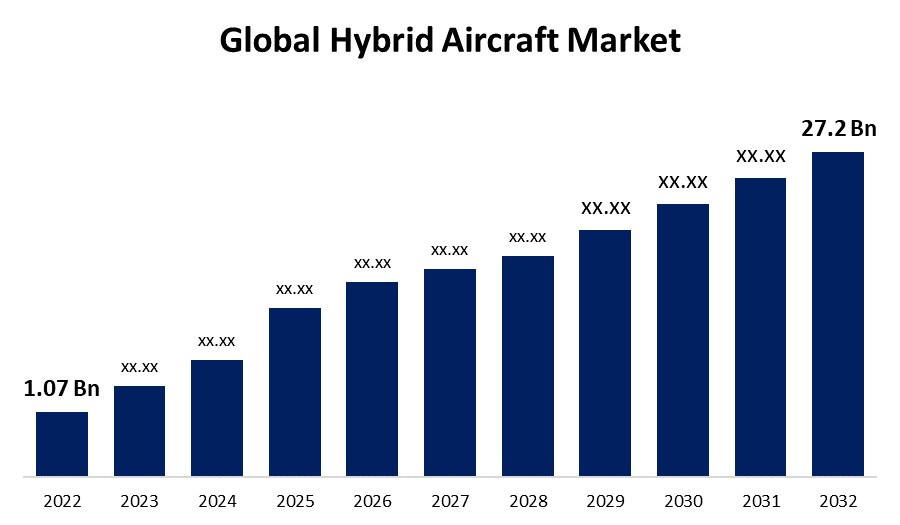Global Hybrid Aircraft Market Size, Share, and COVID-19 Impact Analysis, By Aircraft Type (Regional Transport Aircraft, Business Jets, Light Aircraft, UAVs, AAM), By Power Source (Fuel Hybrid, Hydrogen Hybrid), By Lift Technology (CTOL, STOL, VTOL), and By Region (North America, Europe, Asia-Pacific, Latin America, Middle East, and Africa), Analysis and Forecast 2022 – 2032
Industry: Aerospace & DefenseGlobal Hybrid Aircraft Market Insights Forecasts to 2032
- The Global Hybrid Aircraft Market Size was valued at USD 1.07 Billion in 2022.
- The Market Size is Growing at a CAGR of 38.2% from 2022 to 2032
- The Worldwide Hybrid Aircraft Market Size is expected to reach USD 27.2 Billion by 2032
- Europe is expected to Grow the fastest during the forecast period

Get more details on this report -
The Global Hybrid Aircraft Market size is anticipated to exceed USD 27.2 Billion by 2032, growing at a CAGR of 38.2% from 2022 to 2032. A variety of factors, including increasing environmental regulations, rising fuel costs, and a global push for greener transportation solutions, are driving market growth in this sector.
Market Overview
The global hybrid aircraft market is a rapidly evolving sector of the aviation industry that combines traditional combustion engines with electric propulsion systems. Hybrid aircraft, also known as hybrid-electric aircraft, combine the advantages of traditional aviation technologies with emerging advances in electric propulsion, with the goal of improving fuel efficiency, lowering emissions, and increasing operational flexibility. This novel approach aims to address aviation's pressing issues of environmental sustainability and energy efficiency. Hybrid aircraft combine traditional internal combustion engines (typically powered by aviation fuels) with electric motors powered by batteries or fuel cells. This configuration improves operational efficiency during various flight phases such as takeoff, cruise, and landing. Hybrid aircraft reduce noise and emissions by using electric power sources, making them a promising solution for both commercial and military applications.
Report Coverage
This research report categorizes the market for the global hybrid aircraft market based on various segments and regions and forecasts revenue growth and analyzes trends in each submarket. The report analyses the key growth drivers, opportunities, and challenges influencing the hybrid aircraft market. Recent market developments and competitive strategies such as expansion, product launch, and development, partnership, merger, and acquisition have been included to draw the competitive landscape in the market. The report strategically identifies and profiles the key market players and analyses their core competencies in each sub-segment of the hybrid aircraft market.
Global Hybrid Aircraft Market Report Coverage
| Report Coverage | Details |
|---|---|
| Base Year: | 2022 |
| Market Size in 2022: | USD 1.07 Billion |
| Forecast Period: | 2022-2032 |
| Forecast Period CAGR 2022-2032 : | 38.2% |
| 2032 Value Projection: | USD 27.2 Billion |
| Historical Data for: | 2018-2021 |
| No. of Pages: | 200 |
| Tables, Charts & Figures: | 110 |
| Segments covered: | By Aircraft Type, By Power Source, By Lift Technology, By Region |
| Companies covered:: | Airbus SE, Embraer Textron Inc., ZeroAvia , Ampaire Inc., Pipistrel Group, Aerospace Limited, Yuneec Holding Limited, Leonardo S.p.A., Faradair Aerospace Limited, Boeing, Digisky S.R.L., Groupe Gorge, Others And other key venders |
| Pitfalls & Challenges: | COVID-19 Empact,Challenges, Future, Growth, & Analysis |
Get more details on this report -
Driving Factors
Governments and international bodies are imposing stricter emissions regulations, causing the aviation industry to seek cleaner alternatives. When compared to traditional aircraft, hybrids offer a significant reduction in greenhouse gas emissions and noise pollution, making them an appealing option for meeting these stringent requirements. Due to the use of electric motors during certain phases of flight, hybrid aircraft are inherently quieter than conventional planes. This reduced noise footprint is critical for addressing noise concerns near airports and urban areas, as well as for increasing community acceptance of air travel operations. Battery technology, electric motors, and power management systems are all improving the feasibility and performance of hybrid aircraft. As battery energy density improves, hybrid aircraft can achieve longer ranges and higher power output, potentially expanding their applications.
Restraining Factors
Batteries are heavy, which may affect the aircraft's overall weight and balance. Balancing the desire for longer flight ranges with the need to keep aircraft weight manageable is a difficult task. Hybrid aircraft introduce new technologies and configurations, necessitating the establishment of new safety standards and regulations by certification bodies. Adapting existing regulations or developing new ones can take time and may cause market entry to be delayed.
Market Segmentation
The Global Hybrid Aircraft Market share is classified into aircraft type, power source, and lift technology.
- The AAM segment is expected to account for the largest share of the global hybrid aircraft market during the forecast period.
The global hybrid aircraft market is categorized by aircraft type into regional transport aircraft, business jets, light aircraft, UAVs, and AAM. Among these, the AAM segment is expected to account for the largest share of the global hybrid aircraft market during the forecast period. Because of the growing interest in urban air mobility solutions, which aim to alleviate traffic congestion in urban areas, the AAM segment is seeing significant investment and development. Hybrid-electric propulsion is especially well-suited for these applications, as it provides the range, efficiency, and noise reduction needed for safe and practical urban air transportation. As cities look for innovative solutions to urban congestion and transportation challenges, the AAM segment is well positioned to drive the widespread adoption of hybrid-electric aircraft technology.
- The hydrogen hybrid segment is expected to hold the largest share of the global hybrid aircraft market during the forecast period.
Based on the power source, the global hybrid aircraft market is divided into fuel hybrid and hydrogen hybrid. Among these, the hydrogen hybrid segment is expected to hold the largest share of the global hybrid aircraft market during the forecast period. Hydrogen hybrid configurations use hydrogen fuel cells as the primary power source, with battery-electric backup. Hydrogen fuel cells generate electricity by combining hydrogen and oxygen, emitting only water vapor as a byproduct. This configuration is intended to provide greater energy efficiency and zero-emission flight.
- The CTOL segment is expected to hold the largest share of the global hybrid aircraft market during the forecast period.
Based on the lift technology, the global hybrid aircraft market is divided into CTOL, STOL, and VTOL. Among these, the CTOL segment is expected to hold the largest share of the global hybrid aircraft market during the forecast period. CTOL hybrid aircraft are intended to operate from conventional runways, taking off and landing in the same manner as traditional aircraft. They use hybrid-electric propulsion to improve fuel efficiency, emissions, and operational flexibility throughout the flight cycle. CTOL hybrids are well-suited for regional and intercontinental routes, offering airlines the benefits of lower fuel consumption and emissions while utilizing existing airport infrastructure.
Regional Segment Analysis of the Global Hybrid Aircraft Market
- North America (U.S., Canada, Mexico)
- Europe (Germany, France, U.K., Italy, Spain, Rest of Europe)
- Asia-Pacific (China, Japan, India, Rest of APAC)
- South America (Brazil and the Rest of South America)
- The Middle East and Africa (UAE, South Africa, Rest of MEA)
North America is anticipated to hold the largest share of the global hybrid aircraft market over the predicted timeframe.

Get more details on this report -
North America is projected to hold the largest share of the global hybrid aircraft market over the predicted years. Because of its strong aerospace industry, research capabilities, and active investments in sustainable aviation solutions, North America, particularly the United States, has been at the forefront of hybrid aircraft development. The region has made significant efforts in both commercial and military hybrid aircraft applications, including urban air mobility concepts.
Europe is expected to grow at the fastest pace in the global hybrid aircraft market during the forecast period. The European Union's focus on reducing aviation emissions has fueled significant interest in hybrid aircraft technology. Several European countries have provided funding for research and development in the field of electric and hybrid-electric aviation. This region also has a thriving aerospace industry that is actively researching ways to incorporate hybrid propulsion into various aircraft types.
Competitive Analysis:
The report offers the appropriate analysis of the key organizations/companies involved within the global hybrid aircraft along with a comparative evaluation primarily based on their product offering, business overviews, geographic presence, enterprise strategies, segment market share, and SWOT analysis. The report also provides an elaborative analysis focusing on the current news and developments of the companies, which includes product development, innovations, joint ventures, partnerships, mergers & acquisitions, strategic alliances, and others. This allows for the evaluation of the overall competition within the market.
List of Key Companies
- Airbus SE
- Embraer
- Textron Inc.
- ZeroAvia
- Ampaire Inc.
- Pipistrel Group
- Aerospace Limited
- Yuneec Holding Limited
- Leonardo S.p.A.
- Faradair Aerospace Limited
- Boeing
- Digisky S.R.L.
- Groupe Gorge
- Others
Key Target Audience
- Market Players
- Investors
- End-users
- Government Authorities
- Consulting And Research Firm
- Venture capitalists
- Value-Added Resellers (VARs)
Recent Developments
- In June 2023, Airbus and STMicroelectronics, a global semiconductor leader serving customers across the spectrum of electronics applications, have agreed to collaborate on power electronics R&D to support more efficient and lighter power electronics, which are required for future hybrid-powered aircraft and full-electric urban air vehicles.
Market Segment
This study forecasts revenue at global, regional, and country levels from 2020 to 2032. Spherical Insights has segmented the Global Hybrid Aircraft Market based on the below-mentioned segments:
Global Hybrid Aircraft Market, By Aircraft Type
- Regional Transport Aircraft
- Business Jets
- Light Aircraft
- UAVs
- AAM
Global Hybrid Aircraft Market, By Power Source
- Fuel Hybrid
- Hydrogen Hybrid
Global Hybrid Aircraft Market, By Lift Technology
- CTOL
- STOL
- VTOL
Global Hybrid Aircraft Market, By Region
- North America
- US
- Canada
- Mexico
- Europe
- Germany
- Uk
- France
- Italy
- Spain
- Russia
- Rest of Europe
- Asia Pacific
- China
- Japan
- India
- South Korea
- Australia
- Rest of Asia Pacific
- South America
- Brazil
- Argentina
- Rest of South America
- Middle East & Africa
- UAE
- Saudi Arabia
- Qatar
- South Africa
- Rest of Middle East & Africa
Need help to buy this report?